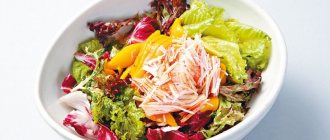Energy value
The calorie content of sliced cucumbers and tomatoes is quite low, although they have a rich composition of nutrients. You can season it with various vegetable oils (linseed, sunflower, sesame, olive), as well as sour cream or mayonnaise. The highest calorie content of cucumber and tomato salad is calculated when using mayonnaise dressing. Table of calories in 100 grams of summer salad when adding various sauces:
| Additive name | Energy value, kcal |
| Sour cream | 30 |
| Sunflower oil | 45 |
| Olive oil | 90 |
| Mayonnaise | 175 |
| Natural yogurt | 30 |
The numbers will differ depending on the amount of salt and the addition of other ingredients: parsley, dill, onion.
Chemical composition and benefits of tomatoes
No less useful, according to experts, is the tomato, which, like the cucumber, consists mainly of water, the vitamin composition of the tomato is also similar, and as for the mineral content, in addition to the potassium, calcium, sodium and magnesium present in the cucumber, it also contains boron and rubidium. Like a cucumber, a tomato prevents the deposition of fats, but the breakdown of fats occurs due to the lycopene contained in it. Tomato is also capable of lowering blood sugar levels, which makes it indispensable in the diet of diabetics.
Beneficial features
Vegetables are quite popular in dietary nutrition. The appetizer goes well with the main fish or meat dish, and is good as a separate snack. It can be eaten at any time during the day, and due to its low energy value, eating chopped vegetables is allowed even several times a day. Cucumber contains a considerable amount of fiber, which is why it is easily absorbed by the human body. The percentage composition of water in it is from 95 to 98%, so its use is recommended for people with obesity, as well as with acid-base balance. Cucumber is especially useful for those who have problems with the cardiovascular system, liver and kidney diseases. The composition of tomato contains many useful substances and vitamins that improve metabolic processes, regulate the functioning of internal organs, and have a positive effect on the immune system. Tomato is a natural antioxidant, making it easier for the body to cope with the oxidative process. Seasonings, including specially prepared ones, season fresh summer snacks, giving them additional taste and combining the ingredients with each other.
How many calories are in a tomato?
Ripe tomatoes contain proteins, starch, fiber, all kinds of organic acids, lycopene, carotenoids, vitamins K, B, C. Tomatoes are useful for heart disease and anemia. The presence of pectin lowers cholesterol levels in the blood.
Due to the presence of many different active substances, tomatoes have a beneficial effect on metabolic processes in the body, the functioning of the genitourinary system and the gastrointestinal tract.
The calorie content of tomatoes depends on the method of consumption.
In fresh tomato
Fresh tomato weighing approximately 100 g. contains 18-20 calories. As you can see, the calorie content of tomatoes is slightly higher than that of cucumbers, but still very low, so they can safely be used for weight loss.
By the way, many diets have been developed based on tomatoes.
What are the benefits of tomatoes?
With sour cream
Onions or herbs are also added to chopped vegetables with sour cream. One tomato and cucumber will be enough for two servings. For a juicy, tasty dish, one or two tablespoons of sour cream is enough. It is best to use a product with a fat content of no more than 10%. Nutritional value per 100 g:
- calories - 30;
- fats - 1.1 g;
- proteins - 1.0 g;
- carbohydrates - 4.2.
Chopped vegetables are seasoned with low-fat sour cream to taste. It is recommended not to “overdo it” with this sauce so that a minimum amount of liquid remains in the salad.
Fasting day on vegetable salad: lots of vitamins, few calories
Vegetables belong to the category of healthy and low-calorie foods - which is why they appear in most diets. So, a cucumber (if its weight is 100 g) has only 15 kcal, so you can eat them without restrictions or risk to your waist. And where do the calories come from if it is 95% water, 0.9% is protein, less than 1 percent is fat and 3% is carbohydrates! Despite this “lean” composition, the vegetable perfectly saturates the body. Another garden product, the tomato, boasts an extremely low energy reserve: it contains 24 kcal.
Thus, if you take these two ingredients in equal quantities, then the calorie content of 100 g of tomato and cucumber salad will not exceed a “ridiculous” 20-25 kcal. Having eaten a small portion of this food - 250 g, the eater will receive only 50 kcal. To prevent it from turning out too dry, just wait a few minutes for the vegetables to release their juice.
An ideal addition to the main ingredients is onion, cut into half rings. It also will not spoil the dietary qualities, since along with salt and ground black pepper it will add no more than 5 kcal. Greens are also not capable of critically influencing this indicator, so you can safely put dill or parsley in the dish.
The most dietary version of this salad is cucumbers, tomatoes and lemon juice. The calorie content of the last ingredient will please those who are watching their weight: per 100 g - 16 kcal and a lot of valuable microelements. And there are 2 calories in a teaspoon. You don’t even need to add salt and other spices to a vegetable mixture prepared from these ingredients.
With mayonnaise
The most high-calorie type of sauce is mayonnaise. One tablespoon holds approximately 25 grams of product. On average, 100 g of regular mayonnaise contains 620 kcal. That is, when using one tablespoon of sauce in preparing a dish, the number of kilocalories increases by 150 units. Nutritional value per 100 g:
- calories - 175;
- proteins - 1.0 g;
- fats - 4.3 g;
- carbohydrates - 3.8 g.
If it is not possible to refuse mayonnaise dressing, it is better to use its dietary form with less fat content. However, even with proper nutrition, the sauce can only be consumed once a day. Additives in mayonnaise are also important: they can increase nutritional value without adding beneficial properties.
A few tips for those who don't want to gain weight from salad
To enhance its dietary properties, use the following recommendations:
- choose tomatoes that are not too fleshy, otherwise they will produce a lot of juice, which will negatively affect the calorie content;
- If you like the taste of sour cream, but are not satisfied with its energy value, then replace it with another fermented milk product - matsoni. It contains 50 kcal per 100 g, and they taste very similar;
- Use only unrefined oils as aromatic infusion.
With yogurt
A dish of fresh vegetables can also be seasoned with low-fat natural yogurt, which you can simply buy in the store or make yourself using a starter. This is a fairly low-calorie type of salad dressing. If desired, add a little mustard to the yogurt. Nutritional information with natural yoghurt dressing:
- calories - 30;
- proteins - 1.7 g;
- fats - 0.7 g;
- carbohydrates - 4.3 g.
In addition, you can add various herbs (parsley, dill, basil, cilantro), ground black pepper, onion or lemon juice. Season according to your own taste. However, the best option for proper nutrition is dressing with low-fat sour cream or natural yogurt. This dish is easily digestible, gives a boost of energy, and contains a small amount of calories.
Calorie content of cucumber and tomato salad
Let's calculate the approximate calorie content of a cucumber-tomato salad:
- 100 g of cucumbers – 15 kcal;
- 100 g of tomatoes – 20 kcal;
- 5 g each of parsley, onion and dill - another 6 kcal.
It turns out that approximately 200 g of salad has a calorie content of only 40 kcal. But without dressing it’s not tasty at all, so add sour cream or butter:
- 25 g olive oil – 220 kcal;
- 25 g sour cream 10% fat – 30 kcal.
The difference is obvious: salad with butter – 260 kcal, salad with sour cream – 70 kcal for the same serving.
About the benefits of cucumbers
It’s worth telling a little about the benefits of cucumbers as a product. After all, some people believe that cucumbers contain nothing but water. And they are fundamentally mistaken. This natural product, grown according to the rules and without excessive use of fertilizers, contains a lot of sugar, mineral salts, and vitamins. And its use reduces the acidity of stomach juice. Usually the cucumber is eaten while still unripe. And its regular use slows down the process of fat formation in the body and prevents its accumulation.
Cucumber and tomato salad for the night. Is it true that you can’t eat cucumbers and tomatoes together?
What salads are the most popular among the residents of our country, of course, Olivier salad, vinaigrette and cucumber and tomato salad. During the Soviet era, when there was no such abundance of food as there is today, these dishes were always present on the tables during any celebration.
Especially loved by many is the summer salad of cucumbers and tomatoes. Bright, with seasonings, herbs and vegetable oil - cucumber-tomato salad has always been popular. Fresh ingredients, no need to boil anything, and easy to prepare. At the same time, excellent taste and aroma.
Recently, there has been a lot of debate about proper nutrition. And suddenly information begins to spread about the incompatibility of these products and the dangers of this salad for the body.
Let's try to figure out if this is true? And what is the harm of eating cucumbers and tomatoes together? Many nutritionists believe that a salad made from these vegetables is harmful. They confirm their opinion with such data.
Can't I have a cucumber and tomato salad?
It turns out that tomatoes and cucumbers are antagonistic vegetables. As a result, they have different effects on the body. Tomatoes have an acidic environment, while cucumbers have an alkaline environment. Therefore, they act on the body in different ways, in direct opposition. A chemical reaction when mixing such components causes salts to precipitate. They have a negative effect on the liver and then on the kidneys, the organs are stressed and have excess salt deposits.
This is not the only reason why you should not mix these vegetables together. To digest tomatoes and cucumbers, the body needs different enzymes. If they enter the stomach and then the intestines together, it causes flatulence. Such negative consequences occur because while the stomach with a certain enzyme digests one vegetable, another rots.
Unfortunately, despite such wonderful taste of the salad, some nutritionists have enough arguments against it. The vitamins that tomatoes and cucumbers are rich in are incompatible. Each of these vegetables is a storehouse of useful vitamins. Separately, they certainly have practical benefits for the body.
Tomatoes are a wonderful vegetable that is good both fresh and processed. It contains vitamins A, B, C, PP, K.E.D and many minerals. Of all these components, there is a large amount of vitamin C.
A cucumber consists of 95% water and contains vitamins B and C. In general, there is nothing special or threatening to human health. The nuance, it turns out, lies in the presence of vitamin C in vegetables. The only difference is that in cucumbers it is presented as ascorbinase, and in tomatoes it is ascorbic acid. These components jointly violate each other’s beneficial properties; if they are consumed together, there will be no benefit from this vitamin.
Therefore, nutritionists advise anyone who is trying to adhere to proper nutrition and curb their gastronomic cravings to give up their habit of eating this salad. Moreover, both vegetables can be perfectly combined with other vegetables and fruits, give no less pleasure and bring quite tangible benefits to the body.
Tomatoes pair well with broccoli, avocado, arugula, asparagus or leafy greens.
Cucumbers will bring maximum benefit with lettuce and herbs.
Many nutritionists say that there will be no particular harm from eating these vegetables together, but there is no benefit either. But it is still not recommended to mix them. They advise eating them separately.
If this problem is not so acute, then it is up to you to decide whether you continue to eat these products in a common salad and together or not. We do not impose any opinions without good reason, but only share with you the information that we have.
Why should you eat green vegetables?
What are the benefits of Chinese cabbage?










